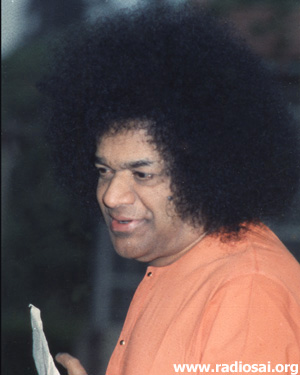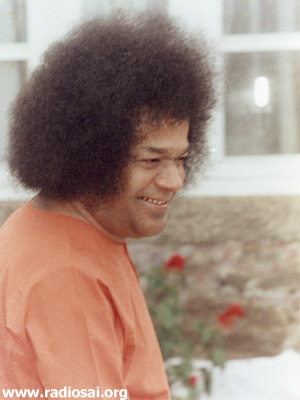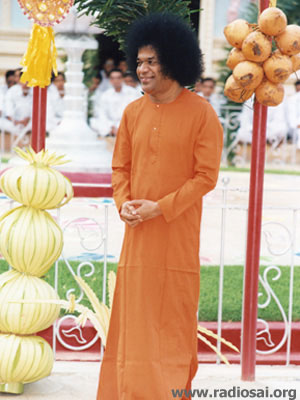 |
 |
 |
 |
| Volume 4 - Issue 05 MAY 2006 |
|
| CONVERSATIONS WITH SAI PART 20 (Continued from the previous issue) |
SAI: That silence that surrounds outside sounds is God. Inside that silence is the eternal sound of 'Om'. There is only one sound, and that is 'Om'. Every other sound arises from Om. H: One is conscious of a force, a strength that rises up in oneself. What is that? SAI: That life force must be turned to God. H: How does one direct that force? SAI: Through faith and love. These must be tended with love and care like tender plants. The bud cannot be forcefully pulled up into a tree.
H: Baba said Ramakrishna Paramahamsa merely touched Vivekananda and transformed him? SAI: Yes. But it was temporary. After a while it fell away. Vivekananda's strong temper rose again and he had to work out his own sadhana. What Ramakrishna accomplished was to reverse the trend to Vivekananda's life from downwards into material life to upwards into spiritual sadhana. Without that, Vivekananda would have continued in materialistic life. H: Can it be said that the reversal given to Vivekananda's life by the touch of Ramakrishna is given to our own lives merely by the Darshan of Baba? SAI: Baba does not do that. He slowly and gradually changes the lives of his devotees. But the change is permanent. H: How should one listen to Swami when He is in conversation or giving a discourse? That is, Swami's words have so many deep and deeper levels. SAI: Swami is speaking to you in body with a voice. Listen in the natural way. At length, body and mind drop away and there is divine direct understanding. SWAMI SAYS ‘YES’ TO EVERYTHING H: Swami is often heard saying, "Yes, yes, yes'. SAI: 'Yes, yes, yes', refers to inner acceptance. Experiences and situations arise in the life of a person. His tendency is to say 'yes' to that which is pleasing and 'no' if the prospect is otherwise... This is a great mistake. Swami says 'Yes, yes, yes' to everything that comes to Him. All is the gift of God. Every experience given by God is good. Through sincere and loving inquiry, that "good" will be found in every experience. 'Yes, yes, yes' refers to inner acceptance. But there is bad work and good work. Whatever they are, they are real. 'Yes, yes, yes' does not change them. A man locks his valuables in a safe and carries away the key in the belief that it is safe. But thieves take the safe and break it open. So, one must be sure that he understands the essentials of every situation. SPIRITUAL LIFE IS EASY! SAI: Vital to spiritual life is self-confidence, the conviction that one is the Atma. Spiritual life is easy. There are some initial problems, as in learning anything. But it is easy. A bowl turned upside down remains dry no matter how heavy the rain. Whereas a bowl turned up collects some rain even though the rain is very light. If the heart is turned towards God, some grace will be received. If the interest and devotion is intense, grace will fill the bowl. It is life in the outer world that is endless trouble, whereas spiritual life is easy. One already has the necessary concentration. To be reborn again requires no work. Not to be reborn again requires much work. To gain wealth requires much work. To remain poor requires no work. THE ‘REALITY’ OF THE DREAM AND WAKING STATE H: When a person is in the waking state, he can observe that the dream experience is a projection of his own mind. Swami says that the waking state is also a dream. But where is the vantage point from which we may observe that the waking state is only a dream? SAI: One may have a dream that he is a child, that he attends school, makes friends, marries, is a father and has a career – a sequence of events that covers 45 years of his life. The dream may occur at 3:15 a.m. and be over by 3:17 a.m. In two minutes of waking time the dreamer has experienced events that extend through 45 years of dream time. When the waking state is transcended, it also is seen to be a dream, and a lifetime in the waking state has taken only a few moments in the transcendental state. The waking state is seen to be a dream, and the dream state, a dream within a dream. The dream state is unreality in truth; the waking state is truth in unreality; and
the transcendent state is truth in truth. The 'I' in the dream H: But Swami, there is another difference between the dream state and the waking state. In the dream state one does not doubt his reality, whereas in the waking state there is an extremely strong doubt. In the waking state one cannot believe that he is a real entity; one sees himself as a shadow and not as a real person engaged in activity. SAI: You see yourself as a shadow. And then there is a change, and you experience yourself as real. Like this it changes back and forth. The two sides of a coin, the face and the obverse. H: Yes, it is like that. SAI: But that is not the typical experience of the waking state. It is a yogic stage due to sadhana. People ordinarily experience the dream state as truth while dreaming and they experience the waking state as truth while awake. What you experience is qualified monism. In the advaitic (non-dualistic) state, even the shadow is seen as a reflection of the Divine.
SAI: In the world, the metal, the stone and the jeweller are all separate, as is the one who will take the ring, and they must be brought together. Whereas, in the world of Swami, the metal, the stone, the jeweller and the one who will take the ring are all one, and that One is God. In the world, time is needed. But God is beyond time. Immediately the ring is ready. A Visitor: It would be of interest if Baba would do a large creation. SAI: Since Swami has taken a body He has imposed certain proper limitations on Himself. Swami has created idols of gold and could just as easily create a mountain of gold. STAGES IN SWAMI’S LIFE H: Swami, people are thinking that after His 60th birthday Bhagavan Baba will step away from contact with the world and that His devotees will no longer have access to Him. SAI: No, not at all. Sai is not separating from the world, nor will He separate from His devotees. The course of an Avathar goes invariably through the same stages. It is the same for every Avathar at all times. The first 16 years are characterized by constant Leelas; then leelas and teaching up to age 45. From age 45 to 60 the emphasis is almost wholly on teaching. At age 60 there is a very big change. SWAMI REVEALS DETAILS ON THE CRUCIFIXTION OF JESUS SAI: They are blood, knots of blood. The body was in a bad condition. It had been hurt and injured over the entire body. At death, the blood came to a sudden stop and the bumps are clots of blood. H: Swami, on the photo enlargements of the statue it also looks as if a sort of slice of the nose had been removed. SAI: The nose is whole. That is a heavy blood stain. When the face itself is enlarged, it is seen as a dead face. Swami made the metal of the body after its death. H: Because of pictures being around and the story and pictures being in books, the little figure on the cross is becoming quite famous. What should be done with it – should it be placed in the new Sathya Sai Museum? SAI: For the museum Swami will make a big image of Christ. The small one was for you. You keep it. What do you make of Christmas? H: I was never really interested in Christianity, but I have paid more attention since Swami made the crucifixion. SAI: I mean what does Christmas represent? H: The birth of Christ is represented. SAI: The 25th is not the birth. It was on the 24th, near midnight. H: Not long ago, I found out something very interesting about the Christian religion. The early Christian Fathers of the Eastern Church knew something of which modern Christians have no idea. The early Fathers taught that one should constantly say ‘Lord Jesus Christ have mercy on me’. There is the constant repetition of Christ's name until the name goes into the heart where the repetition continues without cessation. Along with the repetition of the name, the form of Christ is visualized in the mind. I learned of this through reading an old book, The Way of the Pilgrim, translated from the Russian. SAI: As time goes on, the significant factors of the spiritual path are lost. The Christian mystics took up the repetition of the name of Christ starting about 19 years after his death. As time goes on, human nature comes to the front and the divine is put aside and forgotten. That which was known of the spiritual path after the time of Rama was no longer there at the time of Krishna. And that which Krishna taught was gone when Sai came. It is the same with the Buddhists, the Muslims and the Jains. H: What the early Christian mystics taught was surely the heart of the Christian religion. And one never hears of it today from Christian people.
(To be continued).... – Heart2Heart Team |
| You can write to us at : h2h@radiosai.org |
Vol 4 Issue 05 - MAY 2006
|
Best viewed in Internet Explorer - 1024 x 768 resolution. |
DHTML Menu by Milonic. |
 THE TRANSFORMING POWER OF SAI
THE TRANSFORMING POWER OF SAI H: All the subtle inside and outside tasks to be done! Spiritual life seems very difficult.
H: All the subtle inside and outside tasks to be done! Spiritual life seems very difficult.
 H: The crucifixion of Christ, the metal figure of Christ on the cross that Swami created, the metal, when strongly magnified appears to be more or less covered with small bumps. What are they?
H: The crucifixion of Christ, the metal figure of Christ on the cross that Swami created, the metal, when strongly magnified appears to be more or less covered with small bumps. What are they?